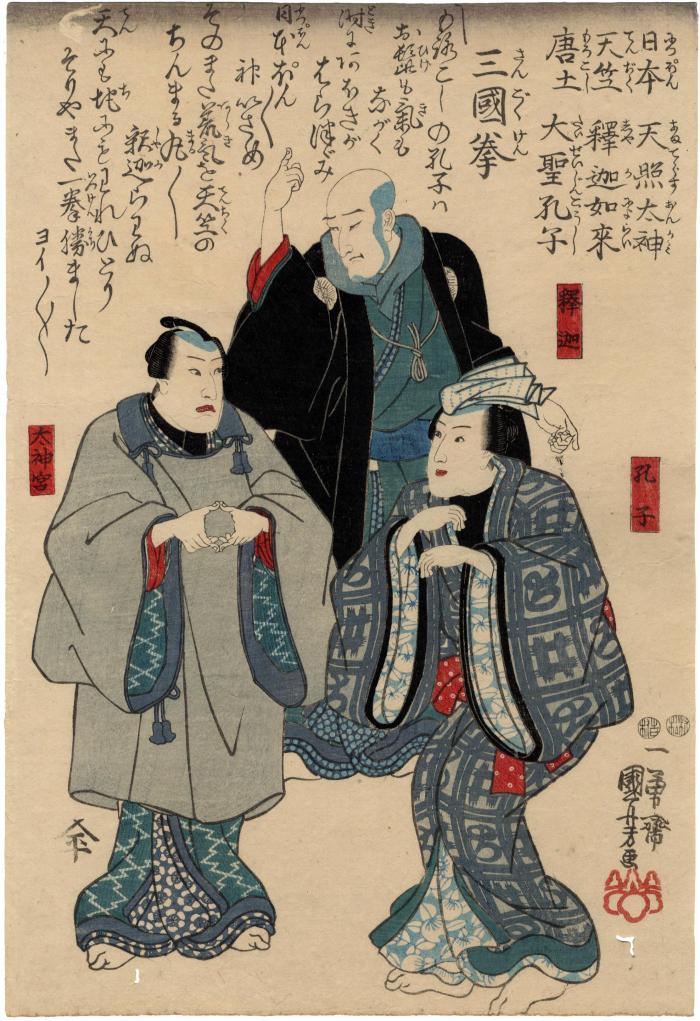Utagawa Kuniyoshi (歌川国芳) (artist 11/15/1797 – 03/05/1861)
Ken game of the Three Countries (Sangoku ken - 三国拳): Nippon Amaterasu onkami,Tenjiku Shaka Nyorai, Morokoshi Taiseijin Kōshi
01/1849
9.75 in x 14.25 in (Overall dimensions) Japanese woodblock print
Signed: Signed: Ichiyūsai Kuniyoshi ga
一勇斎国芳画
Artist's seal: kiri
Publisher: Ōmiya Heihachi (Marks 413 - seal 01-102)
Censor seals: Yoshimura and Muramatsu
British Museum
Waseda University
Tokyo Metropolitan Library Left to right: Nakamura Utaemon IV representing China as Kōshi (Confucius 孔子), Seki Sanjūrō III representing India as Shaka (the historical Buddha 釈迦), Ichimura Uzaemon XII representing Japan as Amaterasu (the Sun Goddess 太神宮).
****
According to the Institut für Ostasienwissenschaften der Universität Wien the text reads:
Morokoshi no Kōshi wa / o-hige mo ki mo / nagaku / toki ni ahoki ga / haratsuzumi / Nippon ponpon / kami isame / sono mata araki o tenjiku no / chinmaru marumaru / shakarawanu / ten ni mo chi ni mo ware hitori / sorya mata ikken kachimashita / yoiyoiyoi"This print shows a man forming a circle with thumbs and index fingers (Amaterasu Ōmikami), a man pointing one finger to heaven and the other to the ground (Shakyamuni) and a man with a towel on his head gesticulating as if he were stroking his beard (Confucius).
Japan Amaterasu Onkami
India Shakyamuni
China the great holy Confucius
Sangoku-ken
Confucius (Kōshi) from China (Morokoshi)
Long is his beard, long his patience
As he slaps his belly with a silly disposition
Nippon ponpon
Cautioning god with wild disposition
Shakyamuni from India, calm and round, offers no resistance
In heaven as on earth, I am the only one
And again I have won a game, yoiyoiyoi
In this print, the portraits of three popular actors are depicted, who made a name for themselves in the performance of the sangoku-ken (three-country-ken) in the play Shinki ikken tori no hatsu koe, which was staged on New Year's of Kaei 2 (1849) at the Ichimura-za kabuki theater. Seeing as the two censorship seals (Yoshimura, Muramatsu) of this print are dated December of Kaei 1 (1848), a month before the performance, it is obvious that this is a print pre-announcing the performance. Furthermore, there are nishiki-e with a similar motive including the sangoku-ken song beginning with the text “Omae onna no na de O-Ise-san” (You are a woman, by the name O-Ise).
Regardless of whether the publication occurred as a pre-announcement of or after the performance, there exist many prints of the sangoku-ken with these two songs in the inscription. Yet, one can assume that the song “Omae onna no na de O-Ise-san” was more popular, as the prints released after the performance with that song text were greater in number.
The three countries in the name three-country-ken refer to Japan (Amaterasu Ōmikami), China (Confucius) and India (Shakyamuni). After song and dance, a ken is played with a three-sided blockade, in which Japan defeats China, China defeats India and India defeats Japan."
****
Illustrated in Ken no bunkashi / Seppu Rinharuto (拳の文化史 / セップ・リンハルト) by Sepp Linhart, 1998, p. 62.
Ōmiya Heihachi (近江屋平八) (publisher)
actor prints (yakusha-e - 役者絵) (genre)
comic prints (giga - 戯画 / kyōga - 狂画) (genre)
Nakamura Utaemon IV (四代目中村歌右衛門: 1/1836-2/1852) (actor)
ken (拳) (genre)
Seki Sanjūrō III (三代目関三十郎: 4/1840 to 12/1870) (actor)
Ichimura Uzaemon XII (十二代目市村羽左衛門: 11/1821 to 12/1850) (actor)
